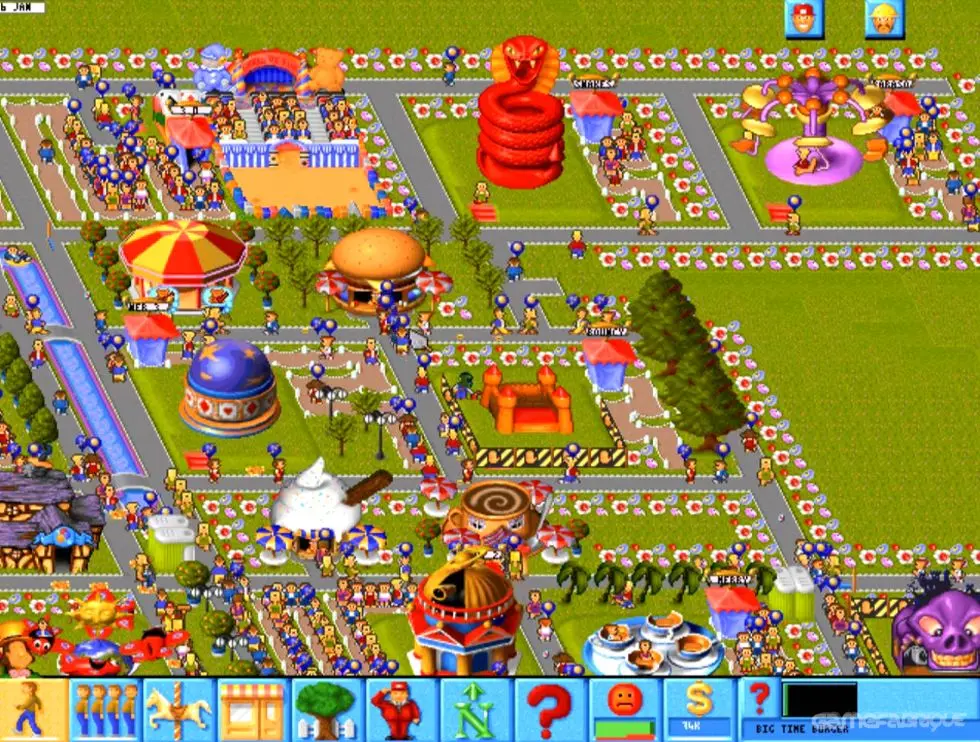Theme Park
- Genre: Simulation
- Players: 1
- Developer: Bullfrog Productions
- Publisher: Electronic Arts
Description
Released in 1994 by Bullfrog Productions under the creative direction of Peter Molyneux, Theme Park pioneered the management simulation genre with its colorful, accessible approach to running an amusement park. This groundbreaking title allowed players to design, build, and manage their own theme park empire, balancing fun attractions with profitable business decisions.
"Welcome to YOUR Theme Park!"
The game's premise was irresistible in its simplicity: start with an empty plot of land and a modest budget, then transform it into a thriving amusement park filled with exciting rides, food stalls, and happy visitors. Players would:
- Design and place increasingly elaborate rides
- Hire and manage staff including mechanics, security guards, and entertainers
- Research new attractions and technologies
- Expand their park's footprint by purchasing adjacent land
- Eventually build a global chain of successful theme parks
This satisfying progression loop kept players engaged for countless hours, constantly striving to create bigger, better, and more profitable parks.
Three Levels of Management Depth
One of Theme Park's most brilliant design choices was its scalable complexity. The game offered three management levels:
- Beginner Mode: The game handled most of the business decisions automatically, allowing players to focus on creative design
- Entrepreneur Mode: Players managed pricing, staff wages, and some financial decisions
- Tycoon Mode: Full control over every aspect of the park, including ride maintenance schedules, ingredient quantities in food, and complex financial instruments
This tiered approach made the game accessible to casual players while providing depth for those who wanted to micromanage every aspect of their business empire.
The Living, Breathing Park
Theme Park's charm came largely from its vibrant, animated world:
- Visitors displayed individual personalities and preferences
- Guests would react visibly to ride experiences, becoming excited, nauseated, or even ill
- Staff members went about their duties with distinctive animations
- Weather changed and affected visitor patterns
- Rides broke down, garbage accumulated, and vandals caused trouble
These simulation elements created a sense that players were managing a real, dynamic environment rather than just manipulating abstract numbers.
The Psychology of Park Management
The game taught players to think like actual theme park operators through subtle behavioral mechanics:
- Salt in food made visitors thirstier, driving drink sales
- Strategic placement of bathrooms became necessary after visitors consumed drinks
- Excitement from thrilling rides increased tolerance for higher prices
- Entertainment like clowns and mascots would distract visitors from long queue lines
- Staff required specific amenities and would strike if underpaid or overworked
These interconnected systems created a playground for psychological manipulation, teaching players the sometimes cynical business practices of real-world entertainment venues.
Ride Construction and Customization
While pre-built attractions were available, Theme Park's rollercoaster designer was where many players spent countless hours:
- Track pieces could be combined to create unique layouts
- Height, speed, and special elements affected the ride's excitement rating
- Test runs with crash-test dummies ensured safety (or revealed spectacular failures)
- Visual customization options allowed for thematic integration
The satisfaction of watching visitors line up for a custom-designed coaster that received high ratings was one of gaming's purest joys.
The Sound of Success
Theme Park's audio design contributed significantly to its immersive quality:
- The upbeat, carnival-esque theme music that perfectly set the tone
- The distinctive "ka-ching" of money being made
- The screams of delight (or terror) from ride passengers
- The ambient chatter of a busy park
- The satisfying construction sounds when placing new attractions
These audio cues provided instant feedback on the park's performance, creating a rewarding sensory experience that complemented the visual elements.
Global Park Empire
After mastering their first location, players could expand to new sites around the world:
- Different countries offered unique challenges and visitor preferences
- Climate variations affected ride popularity and operating conditions
- Land costs and economic factors varied by region
- Competition with rival parks became increasingly fierce
- Research and development unlocked futuristic attractions for later parks
This global progression added longevity to the game, ensuring that mastering one park was just the beginning of a larger business journey.
Technical Innovation for Its Time
Theme Park pushed the technical boundaries of mid-90s gaming:
- The isometric view provided a pseudo-3D perspective with smooth scrolling
- Detailed sprites gave life and personality to visitors and staff
- Complex simulations ran hundreds of park guests with individual parameters
- The interface balanced comprehensive information with user-friendly controls
- Save systems allowed players to maintain multiple parks simultaneously
These technical achievements helped establish the foundation for management simulations that would follow.
The Legacy of Fun and Profit
Theme Park's influence on gaming cannot be overstated:
- It established many conventions of the management simulation genre
- Its accessible approach brought business simulation to mainstream audiences
- It inspired direct successors like RollerCoaster Tycoon and Planet Coaster
- Its balance of creativity and management became a template for The Sims and similar titles
- Its colorful presentation showed that strategy games didn't need to be visually austere
By demonstrating that detailed business management could be not just approachable but genuinely fun, Theme Park expanded the definition of what computer games could be.
For those who spent hours adjusting ride prices, planning optimal bathroom locations, and watching with satisfaction as their bank balance grew, Theme Park represented more than just a game—it was a lesson in entrepreneurship wrapped in colorful graphics and whimsical design. It showed us that the business of fun could be, well, fun.
"Your park rating is increasing! Visitors love your Theme Park!"
This post contains affiliate links. If you click through and make a purchase, I may receive a small commission at no extra cost to you.
